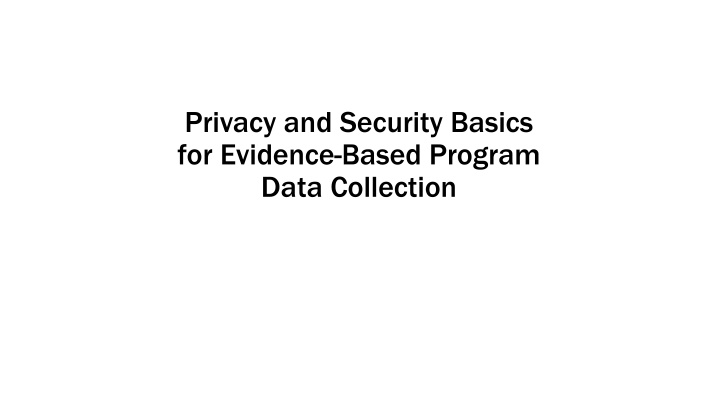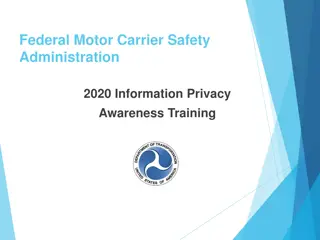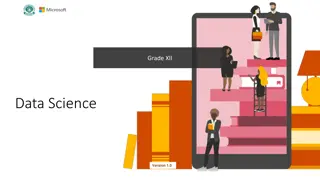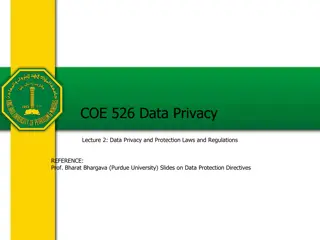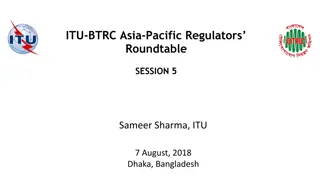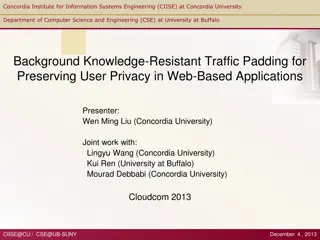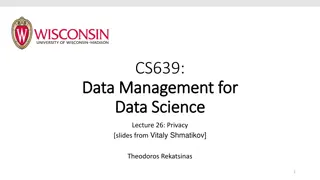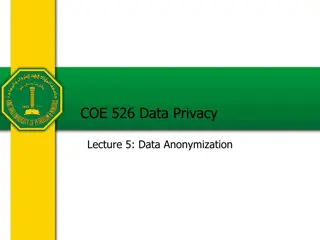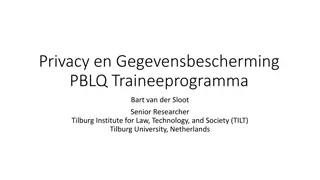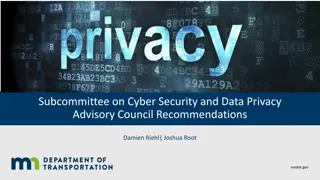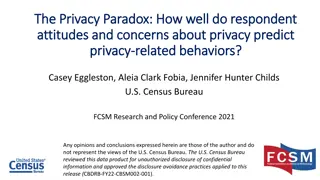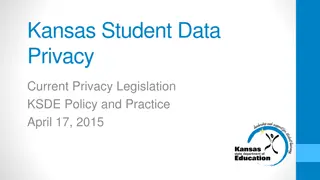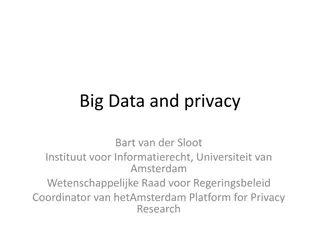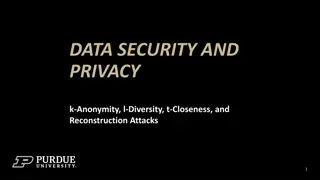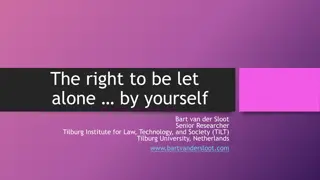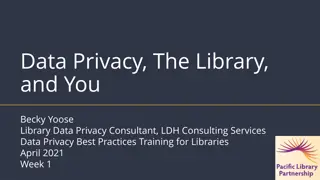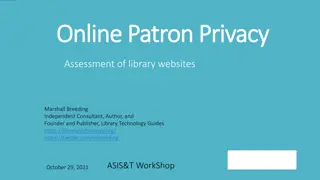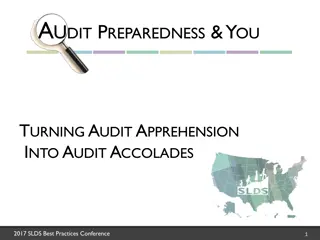Privacy and Security Basics for Evidence-Based Program Data Collection
Explore the essentials of the Privacy Act of 1974 and the training needed to safeguard Personally Identifiable Information (PII) in evidence-based programs. Understand who requires privacy training, the types of information protected, roles and responsibilities, and the importance of data security measures.
Download Presentation

Please find below an Image/Link to download the presentation.
The content on the website is provided AS IS for your information and personal use only. It may not be sold, licensed, or shared on other websites without obtaining consent from the author.If you encounter any issues during the download, it is possible that the publisher has removed the file from their server.
You are allowed to download the files provided on this website for personal or commercial use, subject to the condition that they are used lawfully. All files are the property of their respective owners.
The content on the website is provided AS IS for your information and personal use only. It may not be sold, licensed, or shared on other websites without obtaining consent from the author.
E N D
Presentation Transcript
Privacy and Security Basics for Evidence-Based Program Data Collection
Overview Purpose of the Privacy Act Primary features of the Act Who needs privacy training? Master trainers and lay leaders Program coordinators and data collection/data entry personnel Types of information protected by the Act Disclosure Safeguarding, transporting and disposing of PII Roles and responsibilities Test questions Certificate
Privacy Act of 1974 Protects records that can be retrieved by personal identifiers such as a name, social security number, or other identifying number or symbol. Created in response to concerns about how the use of computerized databases might impact individuals' privacy rights. Requires government agencies to show individuals any records kept on them Requires agencies to follow "fair information practices" when gathering and handling personal data. Places restrictions on how agencies can share an individual's data with other people and agencies. Lets individuals sue the government for violating of these provisions http://www.hhs.gov/foia/privacy/
Who Needs to be Trained? If your work involves the management of sensitive information, Personally Identifiable Information (PII), or protected health information, you need to ensure you are taking precautions to protect data from unauthorized access/disclosure, theft, loss, and improper disposal. Anyone involved in the collection, handling and/or data entry of PII on individuals participating in evidence-based programs, including: Managers Coordinators Other employees Master trainers (MTs) Lay leaders (LLs) Volunteers
What Type of Training is Needed? Training for program coordinators and program implementers The rights of individuals participating in evidence-based programs The appropriate protection of PII shared by program participants at the workshop level The appropriate storage and transfer of participant forms Training for individuals completing data entry and data transfer The appropriate protection of PII shared by program participants at the workshop level The appropriate storage, transfer, and destruction of data forms Security requirements for electronic data transfer, storing, and degaussing (destruction)
Types of Information Covered by the Privacy Act Sensitive: If the loss of confidentiality, integrity, or availability could be expected to have a serious, severe, or catastrophic adverse effect on organizational operations, organizational assets, or individuals. Protected Health Information: Individually identifiable health information that relates to a person s past/present/future physical/mental health, health care received, or payment. http://irtsectraining.nih.gov/publicUser.aspx
Information Protected by the Privacy Act PERSONALLY IDENTIFIABLE INFORMATION (PII) The term Personally Identifiable Information means any information about an individual maintained by an agency, including, but not limited to, education, financial transactions, medical history, and criminal or employment history and information which can be used to distinguish or trace an individual s identity, such as their name, social security number, date and place of birth, mother s maiden name, biometric records, etc., including any other personal information which is linked or linkable to an individual. http://www.gsa.gov/portal/content/104256
Information Protected by the Privacy Act Personally Identifiable Information (PII) Home address Home telephone number Complete date of birth Personal medical information Social Security Number (including just the last four digits of SSN) Personal/private information (if the information can uniquely identify the individual) Photographs Education records Financial transactions Employment history
Disclosure No agency or person shall disclose: any record by any means of communication to any person or another agency without a written request or prior written consent of the individual to whom the record pertains Any means of communication includes oral (phone, in- person), written, and electronic (emails, faxes, texts, tweets, pins, etc.)
Safeguarding PII Must always be treated as FOR OFFICIAL USE ONLY and must be marked accordingly Applies not only to paper records but also includes email, faxes, etc., which must contain the cautionary marking FOR OFFICIAL USE ONLY FOUO Should be stored in locked filing cabinets or other secure containers to prevent unauthorized access Electronic records must be password protected and be transferred via encrypted email
Transporting PII Hand carrying Use a cover sheet to shield contents Using mail Use manila or white envelopes Mark the envelope to the attention of the authorized recipient Never indicate on the outer envelope that it contains PII Using email: Password protect personal data placed on shared drives, the Internet, or the Intranet Use encrypted email Do not send PII to a personal, home, or unencrypted e-mail address Announce in the opening line of the text (NOT the subject line) that FOUO information is contained
Disposing of PII A disposal method is considered adequate if it renders the information unrecognizable or beyond reconstruction. Disposal methods may include: Burning Melting Chemically decomposing Pulping Pulverizing Shredding Mutilating Degaussing (erasing from magnetic field or disc) Deleting/emptying recycle bin
Your Role and Responsibility Take privacy protection seriously Respect the privacy of others Ensure messages, faxes, and emails that contain personal information are properly marked and email is encrypted Don t share PII with individuals who are not authorized Have appropriate transfer, storage, and disposal protocols in place for PII Do not email PII to personal, home, or unencrypted accounts Read the Group Leader Script to advise all participants of their right to consent or refuse use of data about them
Your Role and Responsibility All individuals involved in providing evidence-based programs must sign Non-Disclosure Agreements All individuals involved in data collection, data transfer, and/or data entry must sign Non-Disclosure Agreements Non-Disclosure Agreements should be maintained for three years after the end of the grant and stored by the grantee or the grantee s designee for data collection/data entry Non-Disclosure Agreements do not contain PII, so they can be faxed, e-mailed, or mailed without encryption or privacy restrictions
Master Trainer and Lay Leader Role Use the Group Leader Script at a Session Zero pre-session or at the start of Session 1 and with any new participants who start at Session 2 The script explains why participant data is being collected and how it will be kept secure Emphasize that completing the survey is voluntary Individuals may skip any questions they do not want to answer Individuals may choose to not complete the Survey, but they can still participate in the program Store surveys in sealed envelope and mail to the program coordinator
Program Coordinator/Data Entry Roles Store completed forms in a secure, locked cabinet when not in use Enter data into secure, password protected database such as the National CDSME Database or National Falls Prevention Database Destroy participant data forms after data entry
Test Questions Circle all correct answers 1. Information about an individual that is unique, or identifies or describes him or her (such as Social Security Number, medical history, date of birth, home address), is called: a. Interesting b. Record c. Data d. Personally Identifiable Information
Test Questions Circle all correct answers 2. Disposal methods may include all except: a. Burning b. Shredding c. Tearing in half and putting in the garbage can d. Melting
Test Questions Circle all correct answers 3. The Falls Group Leader Script: a. Describes what participants will learn in the workshop b. Requests participants to share their birth date, address, and sex c. Explains how participant privacy is protected and why data is being collected d. Emphasizes that participants are required to complete all survey forms
Privacy and Security Basics Training Certificate ________________________________________ (Name) Has Successfully Completed the Privacy and Security Basics Training for Falls Program Implementation and Data Collection _____________ Date
Test Answer Code 1. d - Personally Identifiable Information 2. c - Tearing in half and putting in the garbage can 3. c - Explains how participant privacy is protected and why data is being collected
